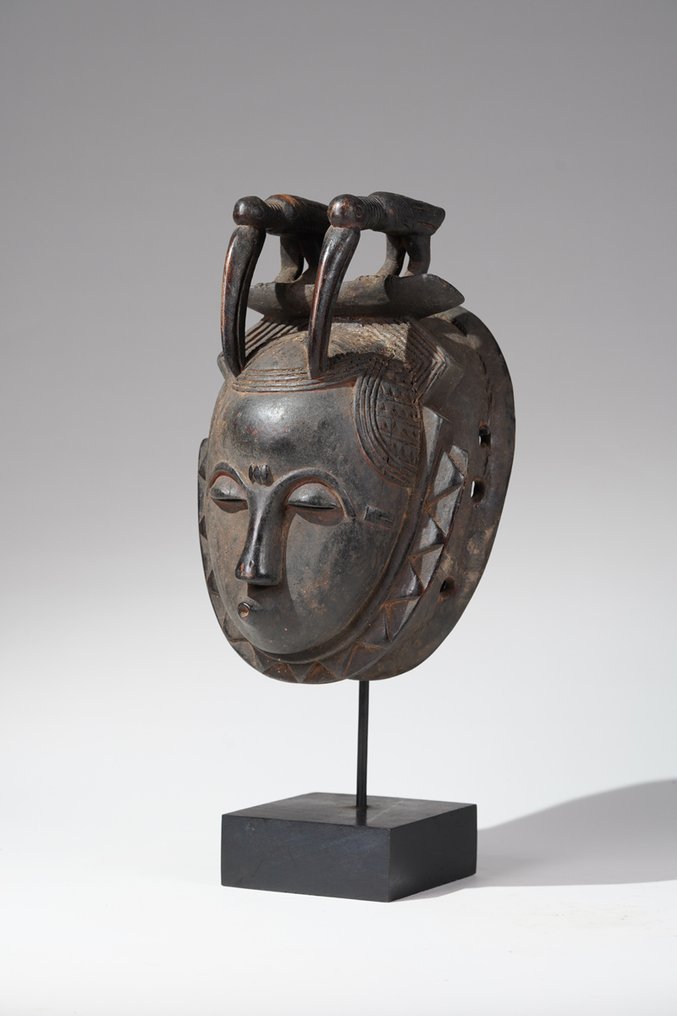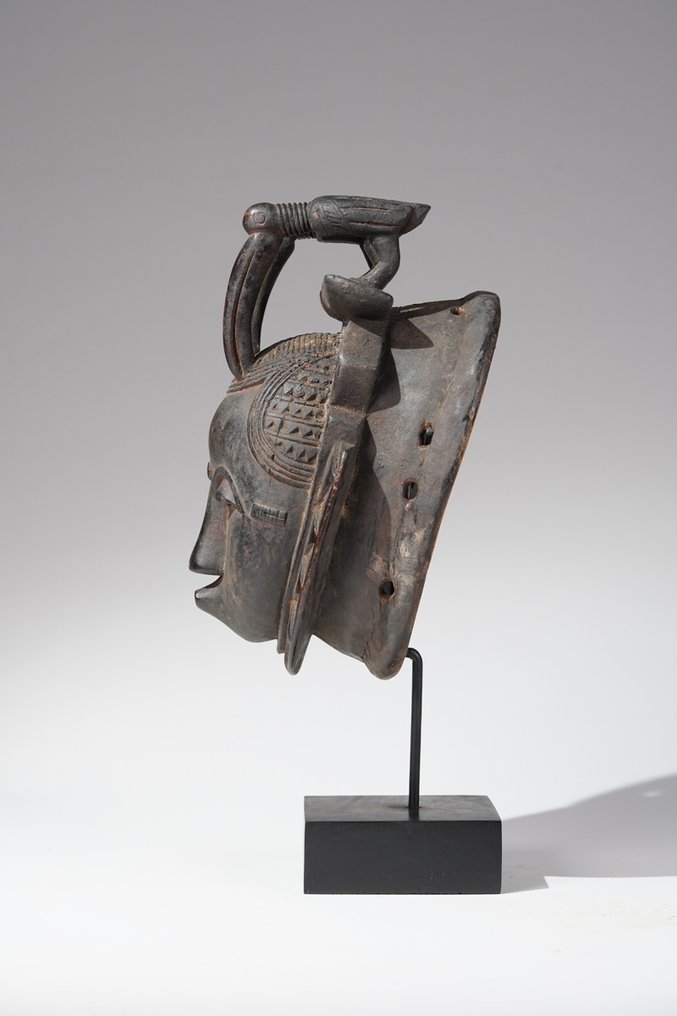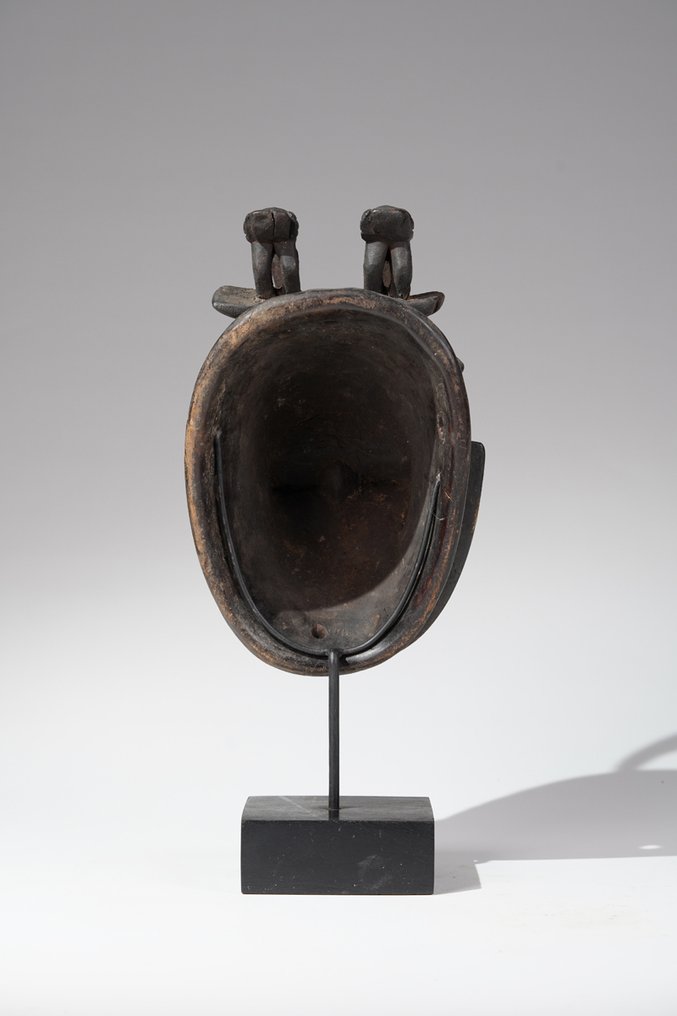Top wie immer,hervorragende Verpackung,danke!
Katso käännösYaure - Norsunluurannikko (Ei pohjahintaa)
Nro. 92804343



A Yaure mask, Ivory Coast, with two Kalao birds on top, incl. wooden stand.
The Yauré and the Baulé are both ethnic groups in West Africa, specifically in the Ivory Coast (Côte d'Ivoire), but they have distinct cultural, linguistic, and historical differences.
Yauré (also known as Yaouré or Yao): They speak the Yauré language, which is part of the Niger-Congo language family, specifically the Kru languages. The Yauré language is not widely spoken outside of their community.
Baulé: The Baulé people speak the Baulé language, which is a member of the Akan language group within the Niger-Congo language family. The Baulé language is one of the most widely spoken languages in the Ivory Coast, and it shares similarities with other Akan
Yauré: The Yauré are primarily located in the central and western parts of Côte d'Ivoire. Their main settlements are near the towns of Divo, Gagnoa, and Soubré, within the broader region that is sometimes called the Kru Coast.
Baulé: The Baulé people are primarily found in the central region of Côte d'Ivoire, particularly around the town of Yamoussoukro (the political capital of the country) and Abidjan (the economic capital), which is in the southern part of the country.
Yauré: The Yauré people have a rich cultural heritage, which includes traditional religious beliefs, festivals, and ceremonies. They have a history of influence from neighboring ethnic groups, as well as their own unique customs and practices.
Baulé: The Baulé are renowned for their art, particularly their wood carving and masks. They have a well-known cultural tradition in dance, music, and ceremonial rituals. The Baulé also practice a mix of indigenous beliefs and Christianity, especially in urban areas.
Yauré: The Yauré people historically had strong interactions with other ethnic groups in the region and have a complex relationship with colonial and post-colonial powers. They were once part of larger political entities and often lived in small, decentralized communities.
Baulé: The Baulé people are one of the groups within the broader Akan cultural family, and they have a well-documented history in both the Ivory Coast and Ghana. The Baulé were known for their organized kingdoms and had a significant role in the establishment of the modern Ivorian state.
Both groups traditionally rely on subsistence farming. Common crops include cassava, yams, plantains, and cocoa. Cocoa is an especially important crop in the Ivory Coast and forms a large part of the country’s economy, with both the Yauré and Baulé involved in its cultivation.
Yauré: The Yauré have indigenous religious beliefs that focus on ancestor worship and animism, although many have adopted Christianity or Islam in modern times.
Baulé: Similarly, the Baulé have a mix of indigenous religious beliefs (including ancestor veneration and animism) and Christianity, with some also practicing Islam.
Language: Yauré speak the Yauré language, while Baulé speak the Baulé language (an Akan language).
Location: The Yauré are mainly found in the west and central regions, while the Baulé are located in the central and southern parts of Côte d'Ivoire.
Culture: Both have rich cultural traditions, but the Baulé are especially known for their art and ceremonial masks.
Economy: Both rely on farming, with cocoa being an important agricultural product for both groups.
Religion: Both groups blend traditional African religions with Christianity and Islam.
Despite these differences, both groups are integral to the cultural and historical fabric of Côte d'Ivoire.
A Yaure mask, Ivory Coast, with two Kalao birds on top, incl. wooden stand.
The Yauré and the Baulé are both ethnic groups in West Africa, specifically in the Ivory Coast (Côte d'Ivoire), but they have distinct cultural, linguistic, and historical differences.
Yauré (also known as Yaouré or Yao): They speak the Yauré language, which is part of the Niger-Congo language family, specifically the Kru languages. The Yauré language is not widely spoken outside of their community.
Baulé: The Baulé people speak the Baulé language, which is a member of the Akan language group within the Niger-Congo language family. The Baulé language is one of the most widely spoken languages in the Ivory Coast, and it shares similarities with other Akan
Yauré: The Yauré are primarily located in the central and western parts of Côte d'Ivoire. Their main settlements are near the towns of Divo, Gagnoa, and Soubré, within the broader region that is sometimes called the Kru Coast.
Baulé: The Baulé people are primarily found in the central region of Côte d'Ivoire, particularly around the town of Yamoussoukro (the political capital of the country) and Abidjan (the economic capital), which is in the southern part of the country.
Yauré: The Yauré people have a rich cultural heritage, which includes traditional religious beliefs, festivals, and ceremonies. They have a history of influence from neighboring ethnic groups, as well as their own unique customs and practices.
Baulé: The Baulé are renowned for their art, particularly their wood carving and masks. They have a well-known cultural tradition in dance, music, and ceremonial rituals. The Baulé also practice a mix of indigenous beliefs and Christianity, especially in urban areas.
Yauré: The Yauré people historically had strong interactions with other ethnic groups in the region and have a complex relationship with colonial and post-colonial powers. They were once part of larger political entities and often lived in small, decentralized communities.
Baulé: The Baulé people are one of the groups within the broader Akan cultural family, and they have a well-documented history in both the Ivory Coast and Ghana. The Baulé were known for their organized kingdoms and had a significant role in the establishment of the modern Ivorian state.
Both groups traditionally rely on subsistence farming. Common crops include cassava, yams, plantains, and cocoa. Cocoa is an especially important crop in the Ivory Coast and forms a large part of the country’s economy, with both the Yauré and Baulé involved in its cultivation.
Yauré: The Yauré have indigenous religious beliefs that focus on ancestor worship and animism, although many have adopted Christianity or Islam in modern times.
Baulé: Similarly, the Baulé have a mix of indigenous religious beliefs (including ancestor veneration and animism) and Christianity, with some also practicing Islam.
Language: Yauré speak the Yauré language, while Baulé speak the Baulé language (an Akan language).
Location: The Yauré are mainly found in the west and central regions, while the Baulé are located in the central and southern parts of Côte d'Ivoire.
Culture: Both have rich cultural traditions, but the Baulé are especially known for their art and ceremonial masks.
Economy: Both rely on farming, with cocoa being an important agricultural product for both groups.
Religion: Both groups blend traditional African religions with Christianity and Islam.
Despite these differences, both groups are integral to the cultural and historical fabric of Côte d'Ivoire.
- 522
- 11
- 4
Beautiful. Thank you
Katso käännösOggetto bello e, come al solito, ben confezionato.
Katso käännösVery satisfied, the item is excellent, the seller is professional, well packaged, delivered quickly I recommend
Katso käännösPerfect
Katso käännöswhat a beauty! and as always: very well wrapped. thank you.
Katso käännösVery very very slow shipping. I accept it for Christmas dates, but it is frustrating (24 days). Otherwise, very good packaging, correct item as described. Does not include certificate (forgotten?)
Katso käännösEn envoi rapide, emballage, parfait.
Katso käännöslivraison très longue 26 jours ! Après réception le Bec de l'oiseau arrive cassé malgré un emballage de qualité exceptionnelle ! Après observations je m'aperçois que la pièce est réparée a la colle !
Katso käännösFirst of all, thank you for the compliment that the mask was well packaged. We go to great lengths to pack our works of art safely. Nevertheless, damage can occur in transit if the courier handles the parcels improperly. In December and even up to the 6th of January there was a lot of chaos at DHL and many parcels arrived days and even weeks late. Some items were at some point repaired by their previous owners in Africa. Sometimes so well that even we cannot recognize the repair and therefore cannot describe it. Please accept our apologies that we did not discover the repair and that the glued-on beak has broken off. If you no longer wish to have the object for this reason, you are welcome to return it to us. Catawiki will then refund the purchase price and postage. Kind regards, Patricia Winheim
Bien reçu le colis ,trés bien préparé et protégeant abondamment la sculpture, mais long délai de livraison. La sculpture est authentique et de bon style du milieu 20e . C'est une chance!
Katso käännösWie immer gute Qualität zum fairen Preis. Hervorragend verpackt! Einziger kleiner Kritikpunkt: 5 Wochen Lieferzeit. Viel Zeit zur Vorfreude :-)
Katso käännösWie immer gute Qualität zum fairen Preis. Hervorragend verpackt! Einziger kleiner Kritikpunkt: 5 Wochen Lieferzeit. Viel Zeit zur Vorfreude :-)
Katso käännös… und ein riesiges Dankeschön an Patricia Winheim.
Katso käännös… ein riesiges Dankeschön an Patricia Winheim.
Katso käännösBestens — voll zufrieden 😊👍
Katso käännösTop wie immer,danke!
Katso käännösexcellent item, as described, fast shipping, thank you
Katso käännösWhat a beautiful mask, thank you so much (again) @Tribalartforum!!!
Katso käännösParfait...merçi .
Katso käännösVery professional packing and order follow up Thank you so much Tribalartforum
Katso käännösMolte grazie tutto altamente professionale AUGURI di un buon anno e di nuovo grazie
Katso käännösals ik volgens de regels meteen betaal verwacht ik ook van de professionele verkoper dat hij zich ook aan de afspraken houdt en niet pas verzendt nadat hij daar toe door Catawiki wordt gesommeerd.
Katso käännösIf you check your DHL tracking number, you can see that your package was on the road for 10 days. This is DHL's responsibility. We regret this, but unfortunately we have no control over it. And between the 24th and the 26th of December and on the 1st of January were official holidays. Kind regards, Patricia Winheim
Alles absolut ok - inkl. Verpackung und Versand… Gerne wieder….
Katso käännös100%
Katso käännösWieder ist ein schönes kleines Objekt gut verpackt bei mir angekommen und erfreut mich!
Katso käännös- 522
- 11
- 4
Top wie immer,hervorragende Verpackung,danke!
Katso käännös